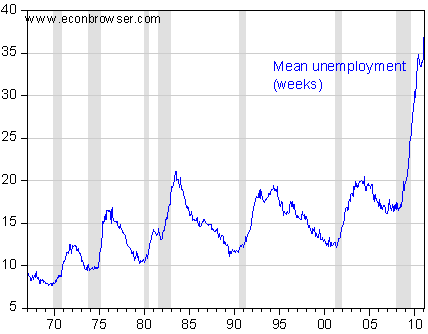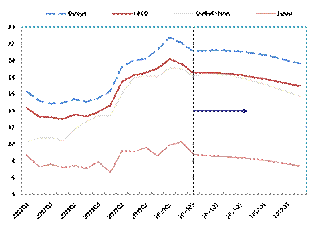The composition and implications of long term unemployment has been vigorously debated over the last year. The most recent informed commentary (skipping non-evidence based assessments [1]) includes Macroblog and SF Fed (earlier discussion here and here). Two conferences on the subject will be held at the University of Wisconsin-Madison, this Friday, and later at the end of April.
The magnitude of the phenomenon can be illustrated by inspecting mean unemployment duration, and number of unemployed over 27 weeks.

Figure 1: Mean unemployment duration, in weeks, seasonally adjusted. NBER defined recession dates shaded gray. Source: February employment situation (household survey).

Figure 2: Number of unemployed over 27 weeks, in ‘000s, seasonally adjusted. NBER defined recession dates shaded gray. Source: February employment situation (household survey).
As I mentioned before, UW-Madison is taking the lead on bringing together scholars to examine the challenges posed by persistent and high long term unemployment (for now, the university has resources to put on conferences; we’ll see how that plays out going forward [2]). The first is this week, on Friday, March 11, and is organized by the Institute for Poverty Research, entitled Employment Prospects for Lower Wage Workers: Easing the Implications of a Slow Recovery Conference, organized by Robert Haveman, Carolyn Heinrich, and Timothy Smeeding:
Employment Prospects for Lower Wage Workers: Easing the Implications of a Slow Recovery Conference
March 11, 2011
Tentative Agenda
- Introduction—Timothy Smeeding, Robert Haveman, and Carolyn Heinrich, University of Wisconsin–Madison
Session One: The Polarization of Job Opportunities in the U.S.
- Moderator: Timothy Smeeding, University of Wisconsin–Madison
- Presenter: David Autor, MIT: “The ‘Polarization’ of U.S.Employment Demand”
- Presenter: Harry Holzer, Georgetown University: “The Future of Middle Class Jobs”
- Discussant: Susan Houseman, W. E. Upjohn Institute for Employment Research
Session Two: Building the Human Capital Necessary to Succeed in the Labor Market of the Next Decade
- Moderator: Robert Haveman, University of Wisconsin–Madison
- Speaker: James Rosenbaum, Northwestern University: “Ability and Success: Do Colleges Have the Ability to Improve Student Outcomes?”
- Presenter: Sarah Turner, University of Virginia: “Do Collegiate Resources Matter? Evidence and Hypotheses”
- Discussant: Richard Murnane, Harvard Graduate School of Education
Session Three: Aligning Policy to Address the Problem of Lower-Wage Workers
- Moderator: Carolyn Heinrich, University of Wisconsin–Madison
- Speaker: Douglas Holtz-Eakin, American Action Forum: “Is Education Reform the Only Answer?”
- Till von Wachter, Columbia University: “The Impact of Recessions on Low-Wage Workers and Policy Implications”
- Discussant: John Karl Scholz, University of Wisconsin–Madison
A graph depicting the trends and projections for youth unemployment across countries highlights the issue. From OECD, Off to a good start? Jobs for Youth.

The second conference, “Long term unemployment in industrial countries: Causes, Consequences and Policy Responses,” organized by myself and Mark Copelovitch, focuses on cross country aspects of long term unemployment, and takes place on April 28. It is sponsored by the Robert M. La Follette School of Public Affairs and the Center for World Affairs and the Global Economy (WAGE) (and co-sponsored by the Department of Economics, the Department of Political Science, and the UW School of Business/CIBER).
Conference on Long term unemployment in industrial countries: Causes, Consequences and Policy Responses
April 28, 2011
Tentative Agenda
Open session
Panel – Long term unemployment in industrial countries: Causes, Consequences and Policy Responses
- Moderator: Tim Smeeding, Director, IRP
- Panelist: Prakash Loungani, Advisor, Research Department, IMF
- Panelist: Kenneth Scheve, Professor of Political Science, Yale
- Panelist: Rob Valletta, Senior Economist, Federal Reserve Bank of San Francisco
- Panelist: Phillip Swagel, Professor of Public Policy, U.Maryland, and former Asst. Secretary of Treasury for Economic Policy
Academic sessions
Session 1: Politics, and Policy (in conjunction with the Political Economy workshop)
- Chair: Mark Copelovitch, Assistant Professor, Political Science and La Follette, UW
- Presenter: Kenneth Scheve: “Inequality and long term unemployment: Implications for Politics and Policy
- Discussant: David Weimer, Dept. of Political Science and La Follette
- Presenter: Phillip Swagel, “Policy responses to long term unemployment” (tentative)
- Discussant: Carolyn Heinrich, Professor, La Follette, UW
Session 2: Identifying the sources of long term unemployment
- Chair: Tom Deleire, Professor, La Follette and Population Health, UW
- Presenter: Prakash Loungani, “Cyclical versus structural unemployment”
- Discussant: Daniel Aaronson, Senior Economist, Federal Reserve Bank of Chicago
- Presenter: Rob Valletta, “Rising Unemployment Duration in the United States: Composition or Behavior?”
- Discussant: Rasmus Lentz, Dept. of Economics, UW
Details on registration to come.
Previous posts on structural and/or long term unemployment: [MDC1] [MDC2] [MDC3] [JDH1]
Update, 11:45am 3/9 Attesting to the importance of this issue, UCLA’s Institute for Research on Labor and Employment is also hosting a conference on this topic.
Reconnecting to Work: Consequences of Long-Term Unemployment and Prospects for Job Creation
UCLA Institute for Research on Labor and Employment
April 1-2, 2011 – Registration ends Monday, March 14, 2011
Reconnecting to Work is a day and a half conference to be held on April 1-2, 2011 on UCLA’s campus. It will focus on the consequences of long-term unemployment and the policies that are needed to address it. The program includes presentations by researchers and advocates, examining the psychological and economic consequences of long-term unemployment as well as policies intended to increase job creation and get the long-term unemployed back into jobs.Richard Freeman, Harvard economist and director of the Labor Studies area at the National Bureau of Economic Research, and senior research fellow at the London School of Economics, has joined the program for the Reconnecting to Work conference as the keynote speaker.
The preliminary program and registration are available here.
Menzie The median duration is 21.2 weeks, which means the only way you get a mean duration of 37.1 weeks is if those who are unemployed long term are unemployed really long term. Two years ago there was not much difference between the mean and median duration. It’s a real question whether those folks will ever be employable again.
2slugbaits: Regarding your observation, my colleague Tim Smeeding refers you (and me) to Gary Burtless at Brookings.
http://imperialeconomics.blogspot.com/2011/03/us-sheconomy.html
Causes? Try US crude oil depletion of 55% per capita over the past 25-30 years and the resulting deindustrialization, decapitalization, financialization, and feminization of the US economy.
And now China’s oil consumption is approaching US oil imports, with peak global oil production and China-Asia growing oil consumption at 8-10%/yr. We are f@&ked, and it ain’t gonna be the fun kind of f@&king.
The US economy has created no net new private, full-time employment since ’96-’97. Gov’t employment surpassed mfg. employment in the ’90-’92 recession; health care and education in the ’01-’03 recession; and health care and education each surpassed total employment in the value-add goods-producing sector in the most recent recession.
Health care (HC) and education (HCE) employment (80-85% female) has grown at 3 times US population since the early ’80s.
Total gov’t (including personal transfers) plus private HC spending is now an equivalent of ~70% of private GDP. HC spending has grown 7-8%/yr. for 30 years, a real per capita rate that is 3 times real per capita GDP!!!
Total HC spending is now nearly 25% of private GDP; that is, this is the approximate cost to labor, employers, and gov’t for HC.
Total HC spending now contributes ~1.1%/yr. to nominal GDP growth in the US.
After thinking we could all flip stocks and houses to one another for fun and profits since the ’90s, are we all now going to make a living changing each other’s bed pans, bathing one another, and taking each other’s temperature and BP?
And perhaps we’ll pay for our health care insurance and out-of-pocket costs by working as medical insurance claims reps and adjusters rejecting each other’s claims for fun?
At the trend rates of real HC and private GDP per capita spending since ’00, HC spending will reach 50% of private GDP before the decade is out and 100% by ’30; obviously, this will not happen, and draconian cuts to HC, “education”, and gov’t are inevitable.
Moreover, total gov’t, private HC, household debt service/DPI, and oil consumption now combine for an equivalent of nearly 60% of total GDP and 91% of private GDP!!!
IOW, the US economy will collapse unless we borrow what we cannot pay back from future income; get sick and consume health care services at 7-8%/yr.; continue to allow gov’t borrowing and spending at 15-16% of private GDP; and continue to drive SUVs and the bottom 90% of household have no ability to save.
The private sector cannot grow with total gov’t at 56% of private GDP; oil consumption of 8% of private GDP; and private health care at 13% of private GDP.
Yet, we boast about how fast health care and education sector employment and spending are growing, with a growing share of e-CON-omists arguing that we should spend EVEN MORE!
Seriously, what kind of mind-altering substances are you academic, gov’t, and Wall St. e-CON-omists consuming? How can you presume that anyone capable of 3rd grade math will take you seriously?
Then again, perhaps I am like a naive 3rd-grader, and it’s all a massive fraud and I just don’t “get it”.
We’ve been talking about some of the structural issues in the labor market for a while now. You can find some our latest reports here: https://www.wellsfargo.com/downloads/pdf/com/research/special_reports/RecoverytoExpansionPeaks_03012011.pdf
And here: https://www.wellsfargo.com/downloads/pdf/com/research/special_reports/LaborMarketFarFromOutOfWoods_01072011.pdf
Menzie,
It would be interesting to see duration by year/month of entry. I think permanent job losers made up a relatively larger fraction of unemployed during the most recent recession compared to prior periods. Think of it as a wave of displaced workers that will not be rehired at their previous employer, and probably not in there previous industry.
I am guessing that more recent vinatages of unemplyed, for example the last 6-12 months, will show a decline in the fraction of permanent job losers to total job losers, (including temporary layoffs).
This would be evidence of a structural change in the economy, with the abnormal wave of permanent job losers representing workers who were structurally displaced. I think some have argued against structural change as an explanation for the observed increase in duration.
This is the best paper I have ever read on minimum wages…
The subject of the minimum wage is out of mode right now, but it will come back very strong in a few years… This paper should lead the way…
http://aysps.gsu.edu/publications/2008/downloads/08-16%20Kaufman-MinimumWage.pdf
tj I think some have argued against structural change as an explanation for the observed increase in duration.
You’ve got it backwards. There may well be a shift to greater structural unemployment, but that shift is a result of the recession and prolonged unemployment. Your formulation of the problem suggests that structural factors (e.g., minimum wage, skill mismatches, etc.) are what’s causing long spells of unemployment. Now it may well be true that going forward increased structural unemployment will push up the NAIRU, but that’s an effect of prolonged unemployment, not a cause. And the costs of that increased structural unemployment could have been avoided if the GOP and bluedog Democrats had been willing to face reality and pass a bigger ARRA.
Mr. Burtless notes the reported labor force participation rate rose from November 2010 in noting that the number of U-3 unemployed for more than 6 months dropped over the same period. However, I believe he may have neglected the series discontinuity due to the census population adjustment which took place in Jan in accounting for the ‘decrease’ in long term unemployment level. If so, I suspect this is significant in analysis over such a short period.
I have duplicated Mr. Burtless’ calculation of a 112K “per month” drop in long-term (27 week) unemployment from Nov 2010 to February 2011 and verified that he has not accounted for the change in level between Dec 2010 and Jan 2011 due to population estimate updates. 69% of the observed “drop” occurs between these two months. The number of long term unemployed actually ROSE 113K from November to December. This leaves the healthy drop of 217K from January to February. I’m told ‘one month does not a trend make’ especially in regard to the household survey. The number of long term unemployed in Feb 2011 is 454% of what it was in Feb 2008, despite people leaving the labor force in the interim.
2slugbaits–
Anecdotal:My aunt was laid off in December 2009. She had not been unemployed ever before in her life. She is 64 years old and had been working since she was 18. She worked for a mortgage broker. She has not yet found employment. I doubt she will ever work again, except in self-employment or in a minimum wage job. Her husband is 5 years younger and self-employed (so he doesn’t count as unemployed even though he’s lost money the past 2 years).
I have personally been working with the unemployed in my home town now for a while now.There is a major concern that nobody seems to be addressing. People who are still relatively young (40 to 55 years of age) are totally being left out of the workforce. When companies begin to rehire and add to their workforce, these workers are being completely ignored. Corporations are now hiring the younger, less experienced people to fill their vacancies. Considering it’s a long time for them to retire, this is going to be a huge problem pretty soon. Just watch those welfare stats rise, along with poverty, foreclosures etc.
Depressingly familiar story. As an immigrant Englishman, it’s like being in the early 80’s UK again See Thatcher’s Britain for some likely outcomes/similarities.
The massive structural unemployment and cruel waste of 45-65 year old talent is followed by alcohol abuse and domestic violence. Egads, without a proper welfare state, it will shock many Americans how hard and far some people are going to fall. It scares the hell out of me.
Check the food stamp rolls – yes it’s a lagging sort of indicator, but the numbers keep climbing. No peak yet. Food stamps have mostly replaced the soup kitchens of the great depression. Next into the grinder….government workers.
We are defined as “CONSUMERS”. That tells it all right there, might as well say “PARASITES”
No one is saying it but the problem is we no longer think of ourselves individually as “PRODUCERS”
Invention drives the economy, this is a fact. How corporations treat inventors has EVERYTHING to do with how the economy operates. In the past an inventor could thrive as an independent agent,the patent office was supposed to aid in this, corporate stacking of the deck has enslaved inventors even if it is a cushy slavery, they are forced to sign contracts turning all their ideas over to their employer, even ideas not useful to the corporation in question that it will NEVER pursue.
Does not anyone see that this kills off 99% of the incentive to see an invention through to reality?
So here we are in an economic model based on invention yet we never think about how we treat inventors. Thats so monumentally blind as to be astounding.